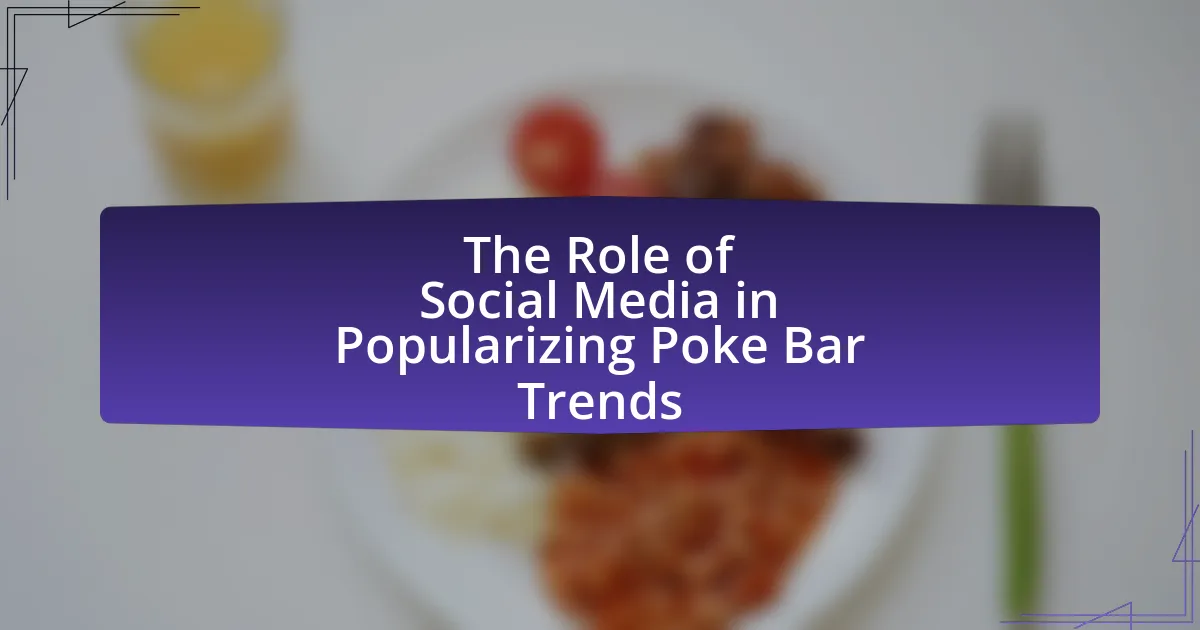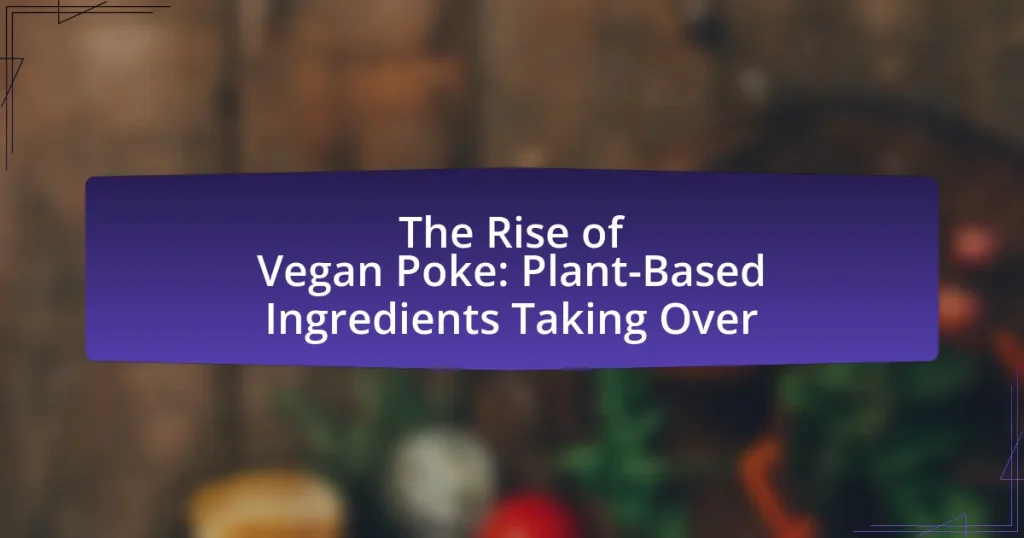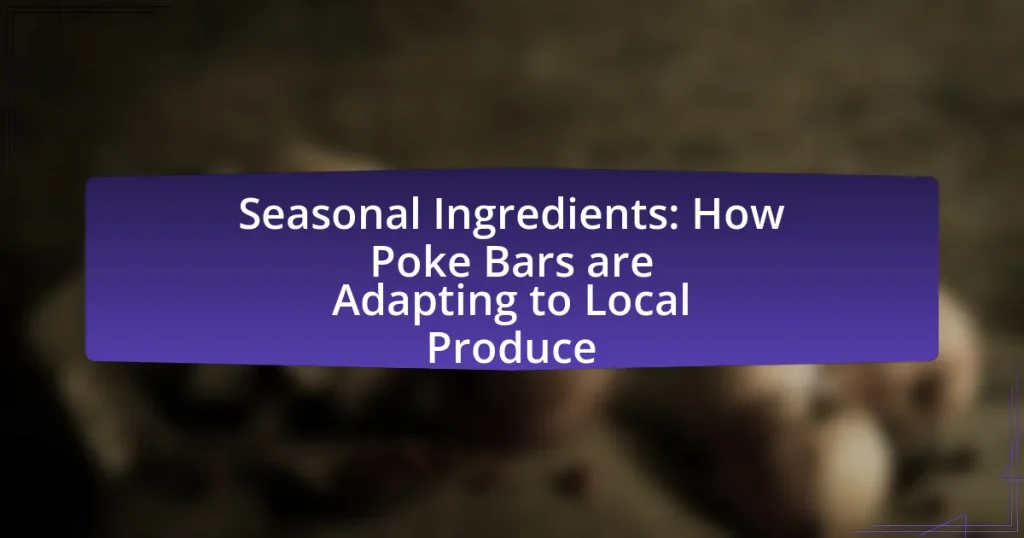The article examines the significant role of social media in popularizing poke bar trends, highlighting how platforms like Instagram and TikTok facilitate the sharing of visually appealing poke bowls. It discusses the influence of social media on food trends, emphasizing the effectiveness of visual content in driving consumer interest and engagement. Key strategies employed by poke bars include leveraging user-generated content, utilizing effective hashtags, and engaging with customers through interactive posts. Additionally, the article addresses the challenges poke bars face in managing their online reputation and offers best practices for enhancing their social media presence to attract and retain customers.
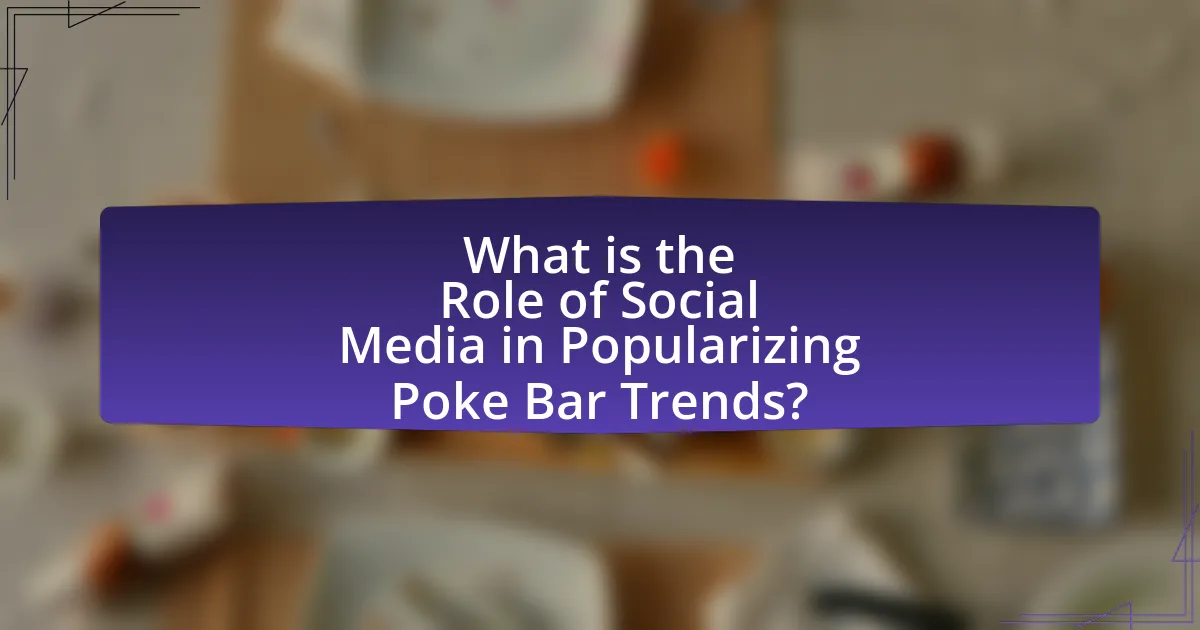
What is the Role of Social Media in Popularizing Poke Bar Trends?
Social media plays a crucial role in popularizing poke bar trends by facilitating the rapid sharing of visually appealing content and engaging user interactions. Platforms like Instagram and TikTok allow users to showcase colorful poke bowls, which attract attention and inspire others to try these dishes. According to a study by the Pew Research Center, 69% of adults in the U.S. use social media, making it a powerful tool for food trends to gain visibility and traction. The hashtag #pokebowl has garnered millions of posts, demonstrating the widespread interest and influence of social media in shaping consumer preferences for poke bars.
How has social media influenced food trends in general?
Social media has significantly influenced food trends by enabling rapid sharing and visibility of culinary experiences. Platforms like Instagram and TikTok allow users to showcase visually appealing dishes, which drives interest and demand for specific foods, such as poke bowls. According to a study published in the Journal of Consumer Research, visual content on social media can increase food desirability and consumption, highlighting the impact of aesthetics on food choices. This phenomenon has led to the rise of food trends that are not only popularized through influencers but also through user-generated content, creating a cycle of trend amplification and consumer engagement.
What platforms are most effective for promoting food trends?
Social media platforms such as Instagram, TikTok, and Facebook are most effective for promoting food trends. Instagram’s visual-centric approach allows food businesses to showcase appealing images and videos, driving engagement and interest. TikTok’s short-form video format enables creative and viral content that can quickly popularize new food trends among younger audiences. Facebook provides a broader reach and community-building features, allowing for targeted advertising and sharing among diverse demographics. According to a 2021 survey by the Pew Research Center, 69% of adults in the U.S. use Facebook, while 40% use Instagram, highlighting their significant user bases for food trend promotion.
How do visual elements on social media impact food popularity?
Visual elements on social media significantly enhance food popularity by attracting attention and stimulating engagement. High-quality images and videos of food can evoke emotional responses, leading to increased sharing and interaction among users. Research indicates that posts featuring visually appealing food content receive 94% more views than those without, demonstrating the direct correlation between visual appeal and audience engagement. Additionally, platforms like Instagram, which prioritize visual content, have been shown to influence consumer choices, with 60% of users reporting that they have been inspired to try new foods after seeing them on social media. This visual impact is particularly relevant in the context of poke bars, where vibrant colors and artistic presentations can create a strong desire to experience the food firsthand.
Why are poke bars becoming popular through social media?
Poke bars are becoming popular through social media due to their visually appealing presentation and the trend towards healthy eating. The vibrant colors and customizable options of poke bowls make them highly shareable on platforms like Instagram and TikTok, where food aesthetics play a significant role in engagement. According to a study by the National Restaurant Association, 70% of consumers are influenced by social media when choosing where to eat, highlighting the impact of online visibility on dining trends. This combination of visual appeal and health consciousness drives the popularity of poke bars in the social media landscape.
What unique aspects of poke bars attract social media attention?
Poke bars attract social media attention primarily due to their visually appealing and customizable food presentations. The vibrant colors of fresh ingredients, such as fish, vegetables, and sauces, create Instagram-worthy dishes that encourage sharing. Additionally, the interactive experience of building a personalized poke bowl allows customers to showcase their creativity, further enhancing engagement on platforms like Instagram and TikTok. According to a study by the Journal of Consumer Research, visually appealing food significantly increases the likelihood of social media sharing, supporting the idea that poke bars leverage aesthetics to capture attention.
How do influencers contribute to the popularity of poke bars?
Influencers significantly contribute to the popularity of poke bars by leveraging their social media platforms to showcase the vibrant and customizable nature of poke bowls. Their visually appealing posts often highlight fresh ingredients, unique flavor combinations, and the overall dining experience, which attracts their followers’ attention. For instance, a study by the Pew Research Center indicates that 72% of teenagers use Instagram, where food-related content is prevalent, thus amplifying the visibility of poke bars. This exposure not only drives foot traffic to these establishments but also encourages followers to try making poke bowls at home, further embedding the trend into popular culture.
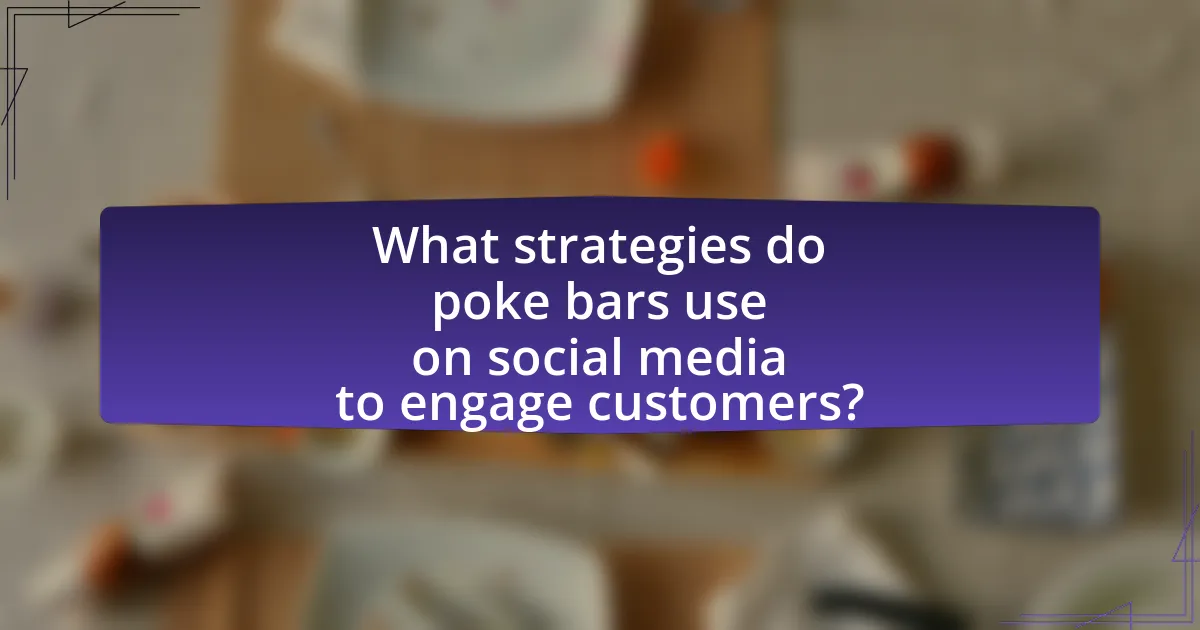
What strategies do poke bars use on social media to engage customers?
Poke bars use interactive content, visually appealing posts, and customer engagement strategies on social media to engage customers. They often share vibrant images of their poke bowls, which attract attention and encourage sharing. Additionally, they utilize polls, contests, and user-generated content to foster community involvement and enhance customer loyalty. For instance, a study by Sprout Social indicates that posts with images receive 650% higher engagement than text-only posts, highlighting the effectiveness of visual content in capturing customer interest.
How do poke bars utilize user-generated content?
Poke bars utilize user-generated content by encouraging customers to share their dining experiences on social media platforms, which enhances brand visibility and engagement. This strategy often includes creating unique hashtags for customers to use when posting photos of their poke bowls, thereby fostering a community around the brand. For instance, a study by the Journal of Marketing Research found that user-generated content can increase consumer trust and influence purchasing decisions, as 79% of consumers say user-generated content highly impacts their purchasing behavior. By leveraging this content, poke bars can effectively showcase their offerings, attract new customers, and build a loyal customer base.
What are the benefits of showcasing customer experiences online?
Showcasing customer experiences online enhances brand credibility and fosters trust among potential customers. When businesses share authentic testimonials and user-generated content, they provide social proof that influences purchasing decisions; studies indicate that 79% of consumers trust online reviews as much as personal recommendations. Additionally, showcasing these experiences can increase engagement on social media platforms, as posts featuring real customers often receive higher interaction rates, leading to greater visibility and reach. This visibility can drive traffic to the business, ultimately resulting in increased sales and customer loyalty.
How can poke bars encourage customers to share their meals?
Poke bars can encourage customers to share their meals by creating visually appealing dishes that are Instagram-worthy. Research indicates that 70% of consumers are more likely to share food photos on social media if the dish is aesthetically pleasing. Additionally, poke bars can implement shareable meal options, such as large platters or customizable bowls designed for sharing, which promote social interaction. Offering incentives like discounts or loyalty points for social media shares can further motivate customers to post about their dining experience.
What role do hashtags play in promoting poke bar trends?
Hashtags play a crucial role in promoting poke bar trends by enhancing visibility and engagement on social media platforms. They categorize content, making it easier for users to discover poke bar-related posts, thereby increasing the likelihood of sharing and interaction. For instance, a study by the Pew Research Center found that 69% of adults in the U.S. use social media, and posts with relevant hashtags can reach a broader audience, leading to higher brand awareness and customer interest in poke bars.
Which hashtags are most effective for poke bar visibility?
The most effective hashtags for poke bar visibility include #PokeBowl, #PokeBar, #HealthyEats, #SushiBowl, and #Foodie. These hashtags are widely used in social media posts related to poke bars, enhancing discoverability and engagement. Research indicates that posts with relevant hashtags can increase visibility by up to 30%, making them crucial for attracting potential customers. Additionally, using location-specific hashtags, such as #YourCityPoke, can further target local audiences, increasing foot traffic to poke establishments.
How can poke bars create their own branded hashtags?
Poke bars can create their own branded hashtags by developing unique, memorable phrases that reflect their brand identity and menu offerings. This involves combining the poke bar’s name with specific themes or ingredients, such as #FreshPokeDelight or #AlohaPokeExperience, which can enhance brand recognition and engagement. Research indicates that branded hashtags can increase user-generated content and customer interaction, as seen in campaigns by successful food brands that leverage hashtags to encourage customers to share their experiences online.
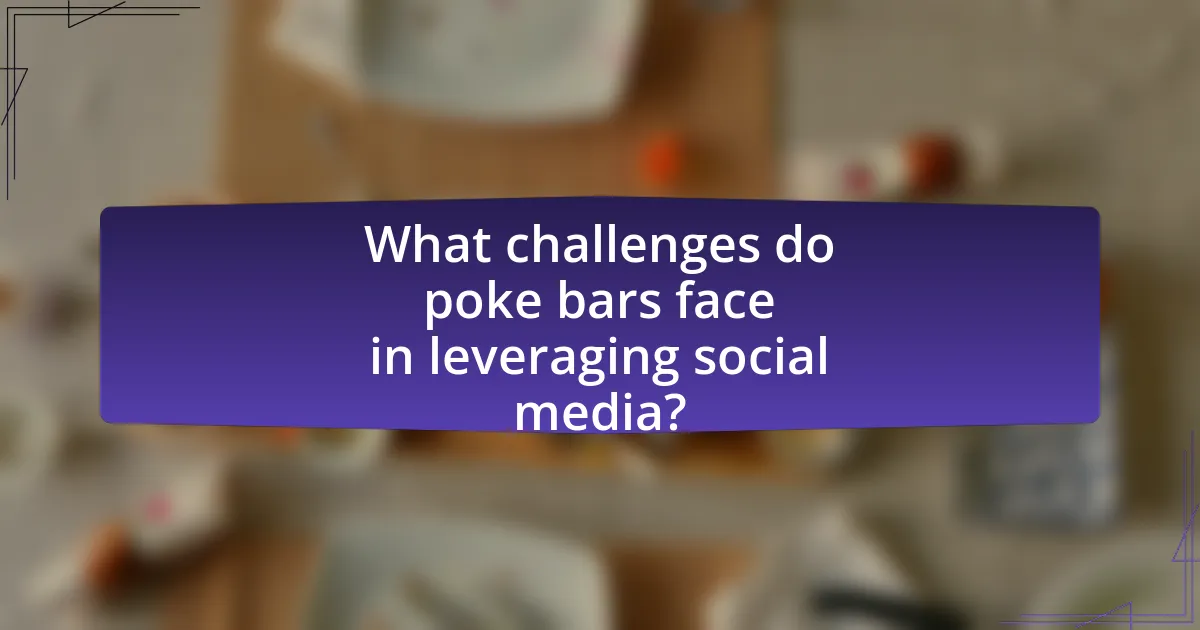
What challenges do poke bars face in leveraging social media?
Poke bars face several challenges in leveraging social media, primarily including competition for attention, maintaining consistent engagement, and effectively showcasing their offerings. The competitive landscape on social media is intense, with numerous food establishments vying for consumer attention, making it difficult for poke bars to stand out. Additionally, maintaining consistent engagement with followers requires ongoing content creation and interaction, which can strain resources. Furthermore, effectively showcasing the visual appeal of poke bowls is crucial, as high-quality images and videos are essential for attracting customers, yet not all poke bars have the skills or resources to produce such content. These challenges hinder the ability of poke bars to fully capitalize on social media as a marketing tool.
How can negative feedback on social media impact poke bars?
Negative feedback on social media can significantly harm poke bars by damaging their reputation and reducing customer footfall. When customers share negative experiences online, it can lead to a decline in trust and credibility, as 79% of consumers trust online reviews as much as personal recommendations. This decline in trust can result in potential customers choosing competitors over the poke bar, ultimately affecting sales and profitability. Additionally, negative comments can spread quickly, leading to a broader audience being influenced by the unfavorable perception, which can further exacerbate the impact on the poke bar’s business.
What strategies can poke bars implement to manage online reputation?
Poke bars can implement several strategies to manage their online reputation effectively. First, they should actively monitor social media platforms and review sites to track customer feedback and respond promptly to both positive and negative comments. Engaging with customers in real-time can enhance their perception of the brand and demonstrate commitment to customer satisfaction.
Additionally, poke bars can encourage satisfied customers to leave positive reviews, as studies show that 70% of consumers trust online reviews as much as personal recommendations. They can also create and share high-quality content showcasing their dishes, customer experiences, and community involvement, which can help build a positive brand image.
Furthermore, implementing a crisis management plan is essential; this plan should outline steps to address potential negative publicity swiftly and transparently. By combining these strategies, poke bars can effectively manage their online reputation and foster a loyal customer base.
How can poke bars respond effectively to customer complaints online?
Poke bars can respond effectively to customer complaints online by promptly acknowledging the issue, providing a clear resolution, and maintaining a professional tone. Quick acknowledgment shows customers that their concerns are taken seriously, which can enhance customer satisfaction. For instance, a study by the Journal of Business Research found that timely responses to complaints can significantly improve customer loyalty. Additionally, offering a solution, such as a refund or replacement, demonstrates commitment to customer service. Maintaining professionalism throughout the interaction helps preserve the brand’s reputation and encourages positive engagement from other customers observing the exchange.
What are the best practices for poke bars on social media?
The best practices for poke bars on social media include engaging content creation, consistent branding, and active community interaction. Engaging content should showcase visually appealing poke bowls, behind-the-scenes preparation, and customer testimonials, as studies show that visual content increases engagement rates by up to 94%. Consistent branding across platforms helps establish a recognizable identity, which is crucial for customer loyalty; research indicates that consistent brand presentation can increase revenue by 23%. Active community interaction, such as responding to comments and sharing user-generated content, fosters a sense of community and encourages customer loyalty, with 70% of consumers feeling more connected to brands that engage with them on social media.
How often should poke bars post to maintain engagement?
Poke bars should post on social media at least three to five times per week to maintain engagement. This frequency allows for consistent visibility and interaction with followers, which is crucial for building a loyal customer base. Research indicates that brands posting this often can achieve higher engagement rates, as regular updates keep the audience informed and interested in new offerings and promotions. According to a study by HubSpot, businesses that post multiple times a week see a significant increase in audience interaction, reinforcing the importance of maintaining an active social media presence.
What types of content should poke bars prioritize for maximum impact?
Poke bars should prioritize visually appealing content, such as high-quality images and videos of their poke bowls, to maximize impact. Engaging visuals attract attention and encourage sharing on social media platforms, which is crucial for brand visibility. According to a study by HubSpot, posts with images receive 94% more views than those without, highlighting the importance of visual content in driving engagement. Additionally, user-generated content, such as customer photos and testimonials, can enhance authenticity and foster community, further amplifying the poke bar’s reach and influence.
How can poke bars measure the success of their social media efforts?
Poke bars can measure the success of their social media efforts through key performance indicators (KPIs) such as engagement rates, follower growth, and conversion rates. Engagement rates, which include likes, shares, and comments, indicate how well content resonates with the audience; for instance, a 2% engagement rate is considered average for the food industry. Follower growth reflects the increasing interest in the brand, and a consistent upward trend can signify effective social media strategies. Conversion rates, which track the number of social media interactions that lead to actual sales or visits to the bar, provide concrete evidence of the impact of social media on business performance. According to a study by Sprout Social, 70% of consumers are more likely to make a purchase from a brand they follow on social media, highlighting the importance of these metrics in assessing success.
What metrics should poke bars track to evaluate their social media performance?
Poke bars should track engagement rate, follower growth, reach, impressions, and conversion rate to evaluate their social media performance. Engagement rate measures the level of interaction (likes, comments, shares) relative to total followers, indicating how well content resonates with the audience. Follower growth reflects the increase in audience size, essential for assessing brand awareness. Reach and impressions provide insights into how many users see the content, with reach indicating unique viewers and impressions counting total views. Conversion rate tracks the percentage of social media interactions that lead to desired actions, such as website visits or purchases, demonstrating the effectiveness of social media efforts in driving business outcomes. These metrics collectively offer a comprehensive view of a poke bar’s social media impact and effectiveness.
How can customer feedback be used to improve social media strategies?
Customer feedback can be used to improve social media strategies by identifying customer preferences and pain points, which allows businesses to tailor their content and engagement approaches. Analyzing feedback from platforms like surveys, comments, and direct messages reveals insights into what customers value, enabling brands to create more relevant and appealing posts. For instance, a study by Sprout Social found that 70% of consumers feel more connected to brands that respond to their feedback, indicating that active engagement can enhance brand loyalty and visibility. By integrating this feedback into their social media strategies, businesses can foster a more engaged community and drive higher interaction rates.
